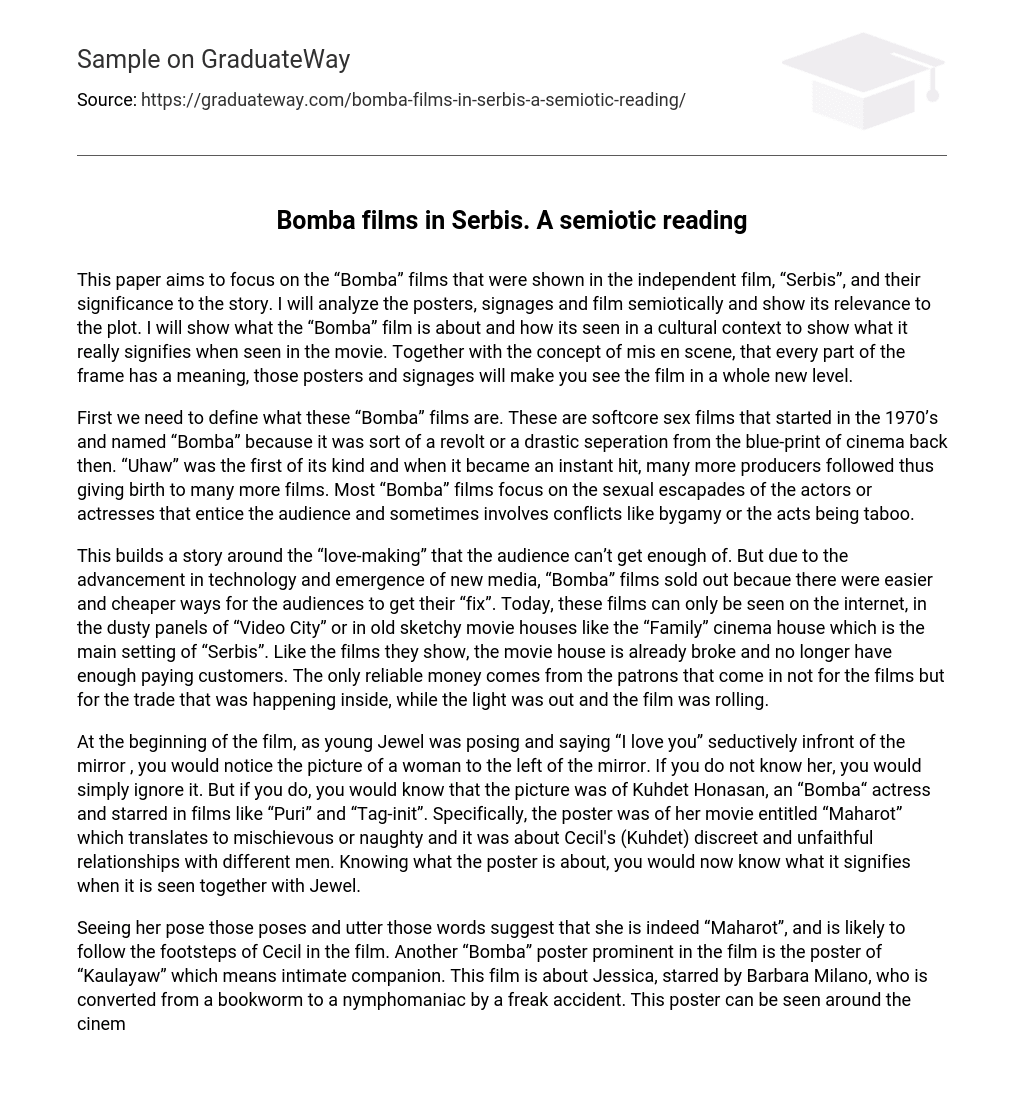The main focus of this paper is on the “Bomba” films within the independent film, “Serbis”, and their importance to the overall story. Through a semiotic analysis of the posters, signs, and film itself, I aim to demonstrate their relevance to the plot. By examining the cultural context in which these films are viewed, I will reveal their true significance within the movie. Additionally, considering the concept of mise-en-scene, where every element within the frame carries meaning, these posters and signs will provide a fresh perspective on interpreting the film.
First, it is necessary to define the nature of these “Bomba” films, which emerged in the 1970s and were characterized as softcore sex films. The term “Bomba” was used because these movies represented a departure from traditional cinema at that time. The first film of this genre, “Uhaw,” was a huge success, leading to the production of many more films in this style. The majority of “Bomba” films center around the sexual adventures of actors and actresses, captivating the audience with explicit content and occasionally incorporating taboo or controversial themes such as polygamy.
The story revolves around the popular “love-making” scenes that captivate the audience, but due to technological advancements and new media, the demand for “Bomba” films declined as there were easier and cheaper ways for audiences to satisfy their desires. Nowadays, these films can only be accessed online, at places like the outdated “Video City” or in questionable cinemas like the “Family” cinema house, which serves as the main backdrop in the movie “Serbis”. Much like the films they exhibit, the theater is struggling financially and lacks enough paying customers. The only consistent source of income comes from patrons who don’t come for the films, but for the illicit activities occurring in darkness while the film is screening.
At the start of the film, young Jewel poses and says “I love you” provocatively in front of a mirror. To the left of the mirror is a picture of a woman. If you are unfamiliar with her, you would likely disregard it. However, if you recognize her, you would identify the woman as Kuhdet Honasan, a Bomba actress known for her roles in films such as “Puri” and “Tag-init”. The poster specifically promotes her movie “Maharot”, which means mischievous or naughty, and tells the story of Cecil’s (Kuhdet) secretive and unfaithful relationships with various men. Understanding the poster’s context allows us to comprehend its significance when viewed alongside Jewel.
Observing her striking those poses and speaking those words implies that she is truly as mischievous as “Maharot” and is likely to emulate Cecil in the movie. Another notable “Bomba” poster showcased in the film is the one for “Kaulayaw,” which translates to an intimate companion. The film revolves around Jessica, played by Barbara Milano, who transforms from a bookworm to a nymphomaniac due to an unexpected incident. This poster can be spotted within the cinema, alongside various characters.
One of the main issues within the family in the story is adultery, making “Kaulayaw” relevant. Nanay Flor sued her husband for having another family and breaking the sanctity of their marriage, but she lost the case as Jerome, her son, testified against her. Before their confrontation, when Jerome walked towards Nanay Flor’s room, there was a focus on the poster. Another “Kaulayaw” issue arises between Nayda and Ronald, which is fully evident at the end of the film when they exchange glances while Lando also looks. There are hints throughout the story, but understanding what “Kaulayaw” means allows readers to interpret what is happening between them and read between the lines.
“Punla” tells the tale of a couple, Manny and Jenny, who desperately long for a child but face the obstacle of Manny’s infertility. In a bold move, Manny turns to his friend Zaldy to be a sperm donor for Jenny. A scene featuring Nanay Flor confronting Allan about impregnating Merly prominently showcases the poster of “Punla”.
Despite her anger, she calmed down and made arrangements for their marriage based on her religious convictions. “Katas,” which translates to juice, is another film called “Bomba” that you can watch at the theater. One particular scene that can be analyzed semiotically is when Nayda finished preparing herself in front of the mirror and then descended the stairs where Ronald saw her. The way he gazed at her suggested a sexual attraction. In some way, this scene also implies that Ronald recognizes Nayda’s enduring allure.
The text speaks about the film “Paninda”, which tells the story of Jasmin, acted by Aleck Bovick, who was forced into prostitution by her mother and stepfather. The story also involves vengeful killings of those who mistreated her. Although the film’s posters are not easily noticeable, they are displayed in the theater and seen by the characters. These posters likely hold meaning and serve a purpose. Both “Paninda” and the cinema share the theme of the sex trade. When watched alongside homosexual individuals, it becomes evident what truly transpires within the theater.
These are some examples of many “Bomba” films seen in Serbis. While the events that unfolded in the Pineda family may not mirror what occurs in the films, semiotics focuses on what these events symbolize – an underground but genuine part of our culture. Apart from showcasing explicit scenes, “Bomba” films also shed light on the lives of people trapped in undesirable situations. From this perspective, “Serbis” can also be seen as a “Bomba” film since it exposes issues that are typically hidden from public view. By recognizing how the Pineda family’s struggles parallel those depicted in various “Bomba” films, we can understand that the explosions are not solely confined to the screen; they are a genuine reality.





